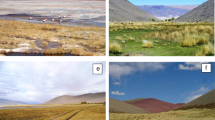Summary
-
1.
Earthworms were collected in pitfall traps from 46 moorland sites over a period of two years; mineral moorland sites were sampled by formalin solution and gave density estimates of 40–100 worms per square metre.
-
2.
Thirteen species were found and A. chlorotica and A. caliginosa were most abundant. Sites were clustered on the basis of species present and showed mineral and peat sites clearly separate. Six species were almost confined to mineral sites and B. eiseni was virtually confined to peat sites.
-
3.
Environmental factors measured at the sites were used in multiple regression analysis to identify those significant in governing the distribution of each species; pH, loss in wieght on ignition of soil, plant association and dominant plant were among those significant.
-
4.
Cluster analysis showed only one cluster of seven species. The distribution of most of these had been shown to be determined by dominant plant species (or a factor associated with this) or by soil pH.
-
5.
Species in a cluster are largely responding to the same group of environmental factors but detailed investigation of microdistribution and laboratory experiments to identify other factors which affect their population dynamics are needed to fully explain the geographical distribution of earthworms.
Similar content being viewed by others
References
Bouché, M.B.: Lombriciens de France: ecologie et systematique. INRA Annales de Zoologie-Ecologie animale (numero hous-serie) 72 (2) 1–671 (1972)
Cragg, J.B.: Some aspects of the ecology of moorland animals. J. Ecol. 49, 477–506 (1961)
Gerard, B.B.: Synopsis of British Lumbricidae. Linnean Society synopses of the British Fauna. London (1964)
Nordstrom, S., Rundgren, S.: Associations of lumbricids in southern Sweden. Pedobiologia 13, 301–326 (1973)
Nordstrom, S., Rundgren, S.: Environmental factors and lumbricid associations in southern Sweden. Pedobiologia 14, 1–27 (1974)
Reynoldson, T.B.: Observations on the earthworms of North Wales. North Western Naturalist 3, 291–304 (1955)
Phillipson, J., Abel, R., Steel, J., Woodell S.R.J.: Earthworms and the factors governing their distribution in an English beechwood. Pedobiologia 16, 258–285 (1976)
Raw, F.: Estimating earthworm populations by using formalin. Nature, Lond. 184, 1661–1662 (1959)
Satchell, J.E.: Some aspects of earthworm ecology. In: Soil Zoology. (Kevan, ed.) pp. 180–202. London: Butterworth 1955
Satchell, J.E.: Methods of sampling earthworm populations. Pedobiologia 9, 20–25 (1969)
Sørensen, T.: A method of establishing groups of equal amplitude in plant sociology based on similarity of species content. Biol. Skr. (K. danske vidensk. Selsk. N.S.) 5, 1–34 (1948)
Svendsen, J.A.: The distribution of Lumbricidae in an area of Pennine moorland (Moor House Nature Reserve). J. Anim. Ecol. 26, 411–421 (1957a)
Svendsen, J.A.: The behaviour of Lumbricids under moorland conditions. J. Anim. Ecol. 26, 423–39 (1957b)
Author information
Authors and Affiliations
Rights and permissions
About this article
Cite this article
Standen, V. Factors affecting the distribution of lumbricids (Oligochaeta) in associations at peat and mineral sites in northern England. Oecologia 42, 359–374 (1979). https://doi.org/10.1007/BF00346599
Received:
Issue Date:
DOI: https://doi.org/10.1007/BF00346599




